
So, have you tried the Autumn Garden Soup recipe yet?
Oh, it’s still simmering. Yes, well, we can’t rush that, can we? Good soup needs a little time and always packs a better punch with that added dash of anticipation.
Good thing we’ve got another kettle on the back burner. Many of the same ingredients, but in picture book form. (Oh, what a clever idea!) Some of us find joy wherever we can 🙂
Have a beautiful fall day, friends. Make nice with spice, and savor the flavor.
RECIPE FOR AUTUMN GARDEN PICTURE BOOK SOUP
Begin by gently sauteing this essential:

Onions and Garlic: An Old Tale, retold by Eric A. Kimmel, pictures by Katya Arnold (Holiday House, 1996). Kimmel’s version of this universal tale was based on the Aggadah, the collection of stories gathered from the Talmud. A merchant sends his youngest son, too kind-hearted to be a shrewd tradesman, on a journey to see if he can trade a sack of onions for something of value. Getzel proves his own worth when a shipwreck changes his life forever. A good lesson in greed, and the watercolor and gouache illos with black line overlay resemble ancient woodcuts.
Next, peel a few potatoes:
Potato: A Tale from the Great Depression, by Kate Lied, pictures by Lisa Campbell Ernst (National Geograhic Society, 1997). Based on a true story about her grandparents, Potato was written when the author was just eight years old (it even won a bookstore contest)! When Clarence loses his job, he travels to Idaho with his wife, Agnes, and little baby, Dorothy, to pick potatoes. They work hard during the day, and collect leftover potatoes at night. When they finally return home to Iowa, they trade potatoes for necessities. The amiable ink and watercolor illustrations, framed against brown paper bag-like pages, are perfection, as is the burlap patterned cover.
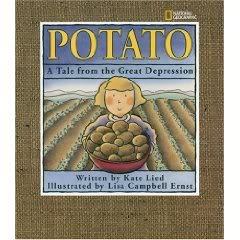

Potato Joe, by Keith Baker (Harcourt, 2008). The familiar one potato, two potato rhyme bounces along merrily, with a game of tic tac toe, a bout with snow, and a rodeo. Watch out for that giant watermelon, and lots of other surprises. A rock and rhyming good time; no duds among these spuds. Fun read aloud!
Then, cut up some carrots (after growing them yourself):
Carrot Soup, by John Segal (Margaret McElderry, 2006). Rabbit plants his spring garden with carrot seeds. He weeds, waters, and waits, but when it’s time to pick the carrots, he discovers, to his horror, that they are gone! Will his friends, Mole, Dog, Cat, Duck and Pig help or surprise him? Whimsical pictures, a chart of carrot types, and a lovely recipe for Carrot Soup are part of the harvest!

The Carrot Seed, by Ruth Krauss, pictures by Crockett Johnson (HarperCollins, 1945). Timeless classic about the power of believing. A little boy plants his carrot seed and tends to it, knowing it will grow despite what everyone else says.
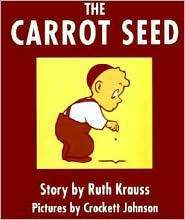
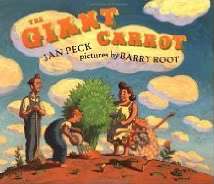
The Giant Carrot, by Jan Peck, pictures by Barry Root (Dial, 1998). A humorous adaptation of the Russian folktale, The Turnip, in which each member of the family contributes to the tending of a carrot plant. Papa Joe digs the hole, Mama Bess drops in the seed, and Brother Abe waters — but what can Little Isabel do? Her joyous singing and dancing are just what the carrot craves to reach its full potential. Barry Root’s warm, rich, and earthy watercolor and gouache illustrations have a retro feel. Delicious recipe for Carrot Pudding is impossible to resist!
Let’s not forget that all-important turnip:
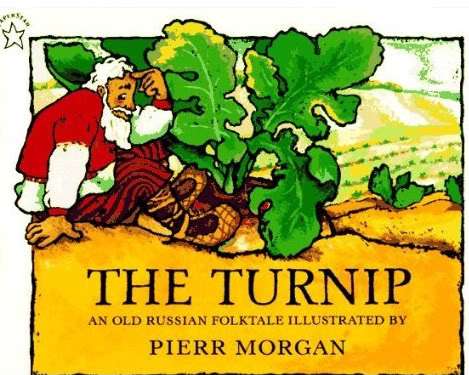
The Turnip: An Old Russian Folktale, illustrated by Pierr Morgan (Philomel, 1990). The traditional tale of a farmer trying to pull out a large turnip is joyously brought to life with charming, gorgeous ink and gouache paintings that gladden the heart with rich color and texture (love the cat with its checkered fur). A good example of the chain story, where successive characters are introduced to solve the problem, thereby sustaining anticipation, and ultimately reminding us that no living thing is too small to make a difference.
What about a sassy tomato, just to keep things interesting?
I Will Never Not Ever Eat a Tomato, by Lauren Child (Candlewick Press, 2000). How does Charlie get his sister, Lola, a very fussy eater, to try those vegetables? Well, it helps to give them proper names, like orange twiglets, green drops, cloud fluff, and moonsquirters. With mixed media illos featuring cool photos of real food (giant potato, inviting plate of peas), cartoony characters, varying font size, and text that literally undulates — you’ve got classic Lauren Child quirkiness, fun, and attitude.

Now, pick out the perfect head of cabbage, to add texture to the soup:
The Cabbage Soup Solution, by Erika Oller (Dutton, 2004). A gentle story about cultivating friendship set against a backdrop of muted watercolors. Elsie lives a simple life on a farm with her two cats, and is good at growing cabbages. One day, when she goes out to pick them as usual, she discovers they’re gone. She falls asleep outside while trying to stand guard one evening, and catches a cold. While she is resting, her cats come to the rescue. Culprit becomes friend and, by story’s end, there is enough cabbage for all.
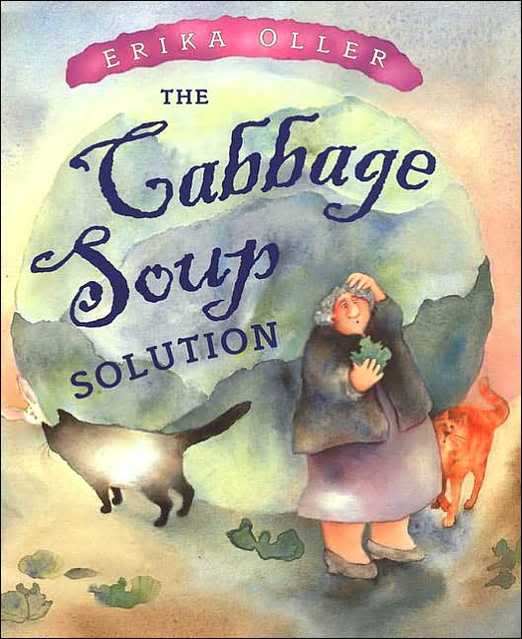
Combine these books, each with its own distinct flavor, then bask in the warmth and joy that will result when they are read aloud and shared with others.
If there is time and desire, add some optional ingredients, to fully extend the pleasure:
Lucas and His Loco Beans: A Tale of the Mexican Jumping Bean, by Ramona Moreno Winner, pictures by Nicole Velasquez and Mary McConnell (Brainstorm 3000, 2002). On a mountain trek with his grandfather one summer, Lucas learns the story of the Mexican jumping bean. A lively, bilingual rhyming story complete with factual pages about the jumping bean, and a quiz on word meanings.


Pardon Me, It’s Ham, Not Turkey, by Lisa Suhay, pictures by Pamela Barcita (Bumble Bee Publishing, 2007). A simple rhyming story that answers the questions, “Why does the President pardon a turkey every year,” and “where was the real first Thanksgiving held?” A pleasant enough nod to Berkeley Plantation in Virginia, with added esteem for pigs.
The Cheese, by Margie Palatini, pictures by Steve Johnson and Lou Fancher (HarperCollins, 2007). A hilarious riff on the old rhyme, The Cheese Stands Alone. One day, a rat wonders, why DOES the cheese stand alone? Why not cozy up and eat it? He is side tracked on his quest by a cat, a not-to-bright dog, and a little girl, who all develop a hankering for cheese. Finally, even after warning them that the cheese must stand alone, the farmer and his wife cannot resist a good nosh; hey, why not make it a party? Off they go to fetch some apples, pears, milk and sausages (yum), while the rat stays behind, doing you know what.

So there you have it! You’ll probably want to read all of these over again, and that’s fine, cuz soup is always better the second day.
Bon Appetit!

You’ve twice described illustrations as watercolor or ink and “gouache”. What is that? I have to write annotations for the books I read each week for my children’s lit class, and it’s often a struggle to figure out what media the illustrator used – is it really deep watercolor, pencils with wash or some other sort of method?
Also, I want vegetable stew now. 😀 Fortunately, I’m planning on making my Apple Beef Stew tomorrow. 😀
LikeLike
you have a great day too! 🙂
LikeLike
I’m not an expert on art media by a longstretch, but my understanding is that gouache differs from watercolor in the pigment to water ratio, and in the size of pigment particles.
Sometimes the media used for a picture book is mentioned on the copyright page. I always like to see that. I often try to guess the medium and then look for that information afterwards to confirm my suspicions. I want to learn as much as I can about making picture books. Each, to me, is a miracle. I especially appreciate artists who do everything by hand, without the use of Photoshop — not that there’s anything bad or inferior about Photoshop illos. I’m of the old school belief that there’s nothing that can duplicate the human hand wielding a pen or brush — and the little “mistakes” or “accidents” that may occur can make a piece even more interesting or genuine.
Will have to check out your apple beef stew recipe!
LikeLike
Thanks, Meg. How are those kindergarteners of yours? 🙂
LikeLike
Mmmm, and I’m behind! Thanks for the nudge about autumn vegetable soup which I must make before autumn turns into the season that should not be named.
And thanks for your sweet note re my story!
LikeLike
It’s starting to feel like “the season that should not be named.” Hard to believe it was in the 80’s just last week. And you’re welcome. Yes, I liked your story 🙂 . . .
LikeLike
From Sherry at Semicolon
I love this post. Wouldn’t it make a great library story time?
LikeLike
Re: From Sherry at Semicolon
I think it would! With soup for lunch afterwards :)!
LikeLike